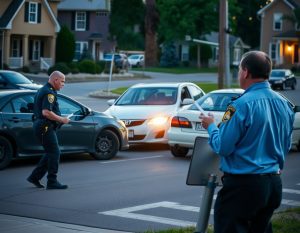Everyday Driving Situations That Lead to Collisions
Parking lots, narrow driveways, and crowded streets set the stage for one of the most common types of crashes: accidents involving vehicles that back up into others. It may happen when someone leaves a tight parking spot or when both cars try to move at the same time. In that split second, a lapse in attention turns into a costly problem.
Who is at fault in a backing-up accident is not always straightforward. However, it almost always comes down to which driver failed to yield the right of way. Distraction plays a significant role. National surveys show that two out of three drivers admit to being distracted in parking lots. With over 50,000 parking lot crashes reported annually that cause more than 500 deaths and over 60,000 injuries, these collisions are far from minor.
Understanding how fault is assigned gives you clarity on what happens next, whether you are seeking damages or defending against a claim.
Who is at Fault in a Backing Up Accident
After a backing accident, both drivers may insist they had the right of way. An officer, an insurance adjuster, or eventually a lawyer will focus on a straightforward question: which driver had the legal right of way to proceed?
When a vehicle reverses into traffic, the assumption is that the driver backing up does not have the right of way. This rule applies whether the car was leaving a driveway, pulling out of a street spot, or exiting a parking stall. On the other hand, a stationary car is rarely considered at fault.
Traffic laws vary by state and city so that local statutes may influence the final determination. That is why two drivers can leave the same accident with very different stories, but investigators still rely on the right-of-way principle as their starting point.
Right of Way in Real-World Scenarios
Backing accidents take place in settings where visibility is often limited and drivers make quick decisions:
- Driveways: Reversing from a driveway into a street typically makes you liable if you hit another vehicle already traveling on the road.
- Parking lots: Most backing collisions happen here. If a driver reverses without checking for pedestrians or vehicles and strikes someone, fault usually lies with the reversing driver.
- Street parking: Backing into traffic from a curb space generally puts liability on the driver who is moving into the lane.
Even when both vehicles are in motion, the rule is simple: the one who should have yielded is the one considered at fault. Signs, painted arrows, and lot-specific rules also play a significant role in an investigation. If you ignored posted guidance, fault is almost always attributed to your actions.
When Both Drivers Share Responsibility
Not every accident involves one careless driver and one blameless victim. In many cases, both drivers contribute to the crash. For example:
- You back out without yielding, but the other driver speeds through the lot.
- Both drivers are reversing at once, and neither checks their mirrors.
- You fail to see the other car, but the other driver was distracted and slow to react.
This concept is called contributory or comparative negligence. In states that follow comparative negligence, fault can be divided between drivers, and each may only recover damages proportionate to the other’s fault. That means your insurance settlement or liability could change dramatically depending on how much responsibility is assigned to you.
This is why clear, factual statements to police and insurers matter. Details such as speed, distractions, and lack of evasive action may influence how damages are divided.
How Backing Accidents Affect More Than Just Vehicles
While many backing collisions result in bent bumpers or cracked taillights, others cause serious injuries. Pedestrians are especially at risk when visibility is low, such as in crowded parking lots or dimly lit garages. Even low-speed impacts can lead to whiplash, back injuries, or broken bones.
Financial fallout is also significant. Repairs, medical bills, lost income, and higher insurance premiums pile up quickly. For working families, these accidents can be life-altering.
The Support You Need After a Backing-Up Accident
Disputes about fault in backing collisions often escalate because drivers rarely agree on who had the right of way. At Costa Ivone, we step in when those disputes affect your financial and physical recovery. Our team of personal injury lawyers investigates the details, collects evidence, and builds a strong compensation case.
We also represent employees injured while driving for work or hurt in workplace accidents, offering skilled representation as workers’ compensation lawyers.
If you have been involved in a backing-up accident, do not leave fault up to guesswork. Reach out to us for legal support that is approachable, thorough, and tailored to your case.
Turn a Moment of Confusion Into a Clear Path Forward
One sudden mistake in a parking lot or driveway should not define your future. If you are dealing with medical bills, repairs, or questions about liability after a backing-up accident, you deserve guidance and representation you can trust.



